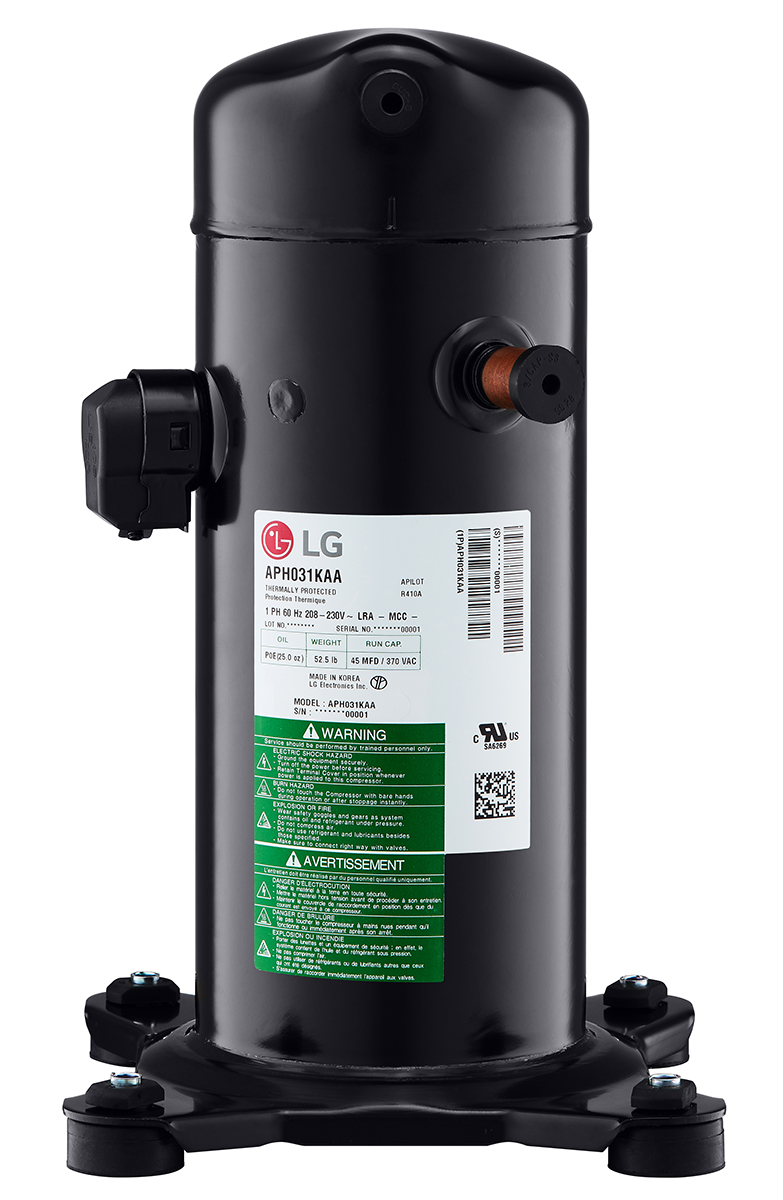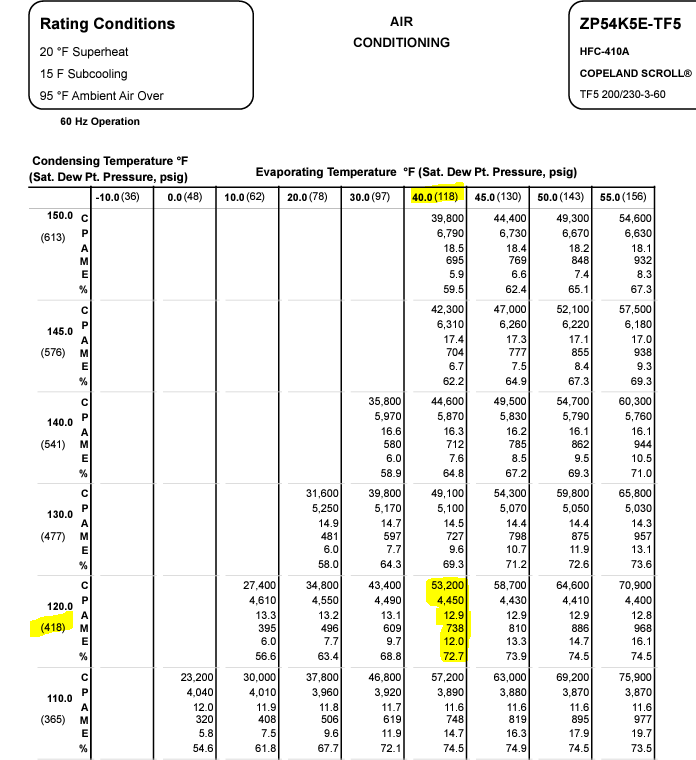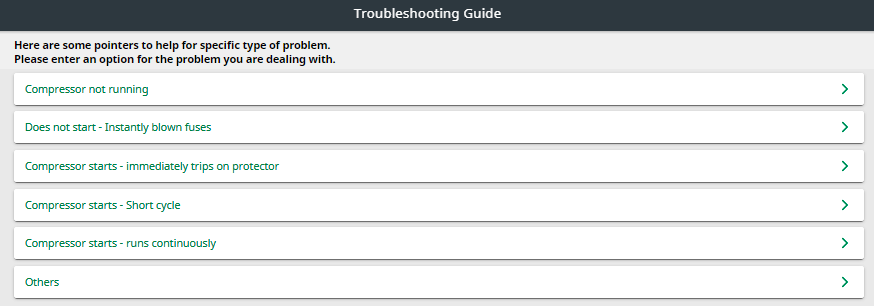Without a functioning compressor, the refrigerant cycle won’t exist. What should HVAC technicians be checking when it comes to compressors to ensure everything is going off without a hitch? Following are seven things to check to make sure a compressor is working properly — long before issues start cropping up.
1. Hook up a set of compound gauges.
Those gauges are there to monitor suction and discharge pressure to ensure the compressor is functioning correctly, said Jeff Horne, key account manager for LG. Operational pressures at an ambient temp can be found on the HVAC system itself or by a QR code a company provides.

COMPRESSED: Compressors remain the heart of any HVAC system. Pictured is the APH031KAA Thermally Protected Compressor from LG. (Courtesy of LG)
2. Check the wiring from the electrical box to the compressor for proper phasing.
Without the compressor compressing, neither the condensation nor the metering device can function as they ought to. Cross wiring those wires within the metering device would (figuratively) turn the entire system upside down.
Proper rotation on any compressor is critical to scroll operation, said Benjamin Majerus, applications director at Danfoss.
“Within the first few seconds of a startup, listen for normal noise and watch gauges to make sure the system is building pressure. If not, shut down ASAP and ensure wiring is correct.”
Some systems even have built-in protection within the compressor itself to prevent reverse rotation or prevent the damage that would occur from reverse rotation.
3. Check oil level.
Another thing to check to ensure the compressor is functioning properly occurs at compressor startup. Running the oil at the lowest capacity to get that lower mass flow, while also monitoring the oil return in the compressor sight glass, can inform a contractor on whether or not the compressor is good to go, said John Vondenstein, senior application engineering manager for Danfoss. However, additional oil is needed for systems using charges above compressor charge limits.
And remember, full sight glass doesn’t mean the compressor is full of oil.
“Refrigerant can migrate back to the oil and give a false oil level. Check the temperature of the sump to see if the crankcase heater is working,” Vondenstein said.
4. Check system refrigerant charge per the manufacturer’s recommendations.
Improper charge level can lead to inadequate suction superheat levels, which result in possible liquid floodback for too much charge or high compressor temperatures for too little charge, said Majerus. Verifying protections are in place (heaters, check valves, pumpdowns, etc.) or even moisture indicators, if available, will provide a view of refrigerant quality.
5. Ensure all compressor safeties are installed and operational per the desired settings.
Things to look out for are high and low pressure switches, discharge temp sensors, oil level sensors, and crankcase heaters, said Vondenstein.
6. Check the compressor’s current draw during operation.
According to John Roberts, service engineer, HVACR Technologies for Emerson, to ensure the internal running gear is intact and free of friction, checking the compressor’s current draw during operation is critical. Many technicians assume the main cause of a compressor’s failure is electrical; however, most issues stem from a mechanical issue.
EXAMPLE: This chart tells techs what they may need to check to troubleshoot this portion of the compressor efficiently. (Courtesy of Emerson)

7. Monitor the compressor’s winding resistance to ensure motor is working correctly.
This is the best technique to ensure the motor is working correctly. Today’s technological advances allows for this to be checked through a mobile app.
“It’s important to note that these readings should be within +/- 7% of the values shown … and resistance readings can be slightly high when the compressor motor is hot,” Roberts said.
When It’s Not Working
The temperature of the room can be a nice little giveaway as to whether or not the compressor is functioning. In fact, it could be the first thing a contractor might notice.
“Your temperature, whether it's a refrigeration box or your home … you're going to know what that set point on the thermostat should be,” Horne said.
And if the cooling temperature of the room is higher than the set point, or the heating temperature of the room is much lower, likely the compressor is not working.
James Stevenson, technical engineer, HVACR Technologies for Emerson, shared an example of when a Copeland scroll compressor wasn’t functioning properly and how it was discovered.
“It’s worth nothing this compressor operates pressure of 418 pounds per square gauge (PSIG) high-side pressure and 118 PSIG low-side pressure. By using the performance chart below, I mapped out the expected current draw to better understand if everything in the compressor was working properly. I was able to determine that this compressor should be pulling around 12.9 amps at the given running condition, and if the amp draw is higher, this could indicate internal friction and the possibility of an ongoing system issue.”
EXAMPLE: This chart tells techs what they may need to check to troubleshoot this portion of the compressor efficiently. (Courtesy of Emerson)

A contractor will also want to ensure the compressor’s pressure is equalized. If the compressor is not single-phased, check the fuses, contactor, and electrical connections, Majerus said. Checking the operation of the condenser fans/pumps and evaporater fans/pumps can be done to troubleshoot that compressor upon awareness that it’s not functioning.
Horne said upon discovering that the compressor isn’t functioning as it should, an HVAC contractor should ensure the breaker or power surce is not tripped or off the system or electrical panel.



Report Abusive Comment